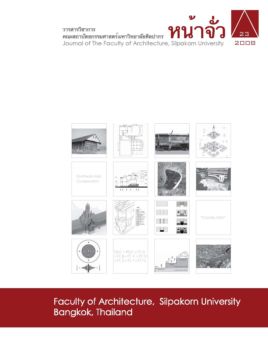Controlling A Fast-Growing Urban Region: A Case Study in the Bangkok Metropolitan Region
Keywords:
Metropolitan, Bangkok, Fast-growing Urban Region, ผังเมืองมหานคร, พื้นที่ชานมหานคร, นโยบายผังเมืองAbstract
The paper examines a planning situation that occurs in an area that is brought under a strong development control. It outlines what kinds of planning tools are applied to control the area’s growth, how they are implemented, what effects
they lead to the area, why the planning situation is what it is and what implication of this is for urban planning practice.
The paper is based on a research in a suburban segment of the Bangkok Metropolitan Region, called Bang Kachao. The territory is a vast agricultural enclave surrounded by high-density built-up settlements of an industrial heartland. In 1977, it was designated to be an environmentally preserved zone for the metropolitan region. This was followed by a series of planning measures, such as the creation of public recreational areas, land use zoning, building code control and land purchasing programme. All measures were evidently physical-oriented, and most have failed to achieve their planned targets.
Although the planning intervention has succeeded in keeping the majority part of Bang Kachao undeveloped, it has never created the area’s physical form in the way desirable according to the planning objectives. Most preserved agricultural
land has been unproductive, poorly maintained and deteriorating and become jungle-like. Most public recreational sites have been in poor state. Squatter settlement has continually expanded. Moreover, despite the area located in a prosperous zone, its local economy has been stagnant.
The study argues that the planning failure is a result of the combination of poor planning approach and poor enforcement. The physical-bias measures, failure to recognise the dynamic characteristic of the area surrounding, apolitical nature
of the planning process, and ignorance of implementation capability, monitoring activity and enforcement constraints are regarded as major factors that constitute planning weaknesses. The paper discusses that despite the wide recognition of such planning situation, many governments have repeated such problematic approach, and thus inevitably experienced undesirable planning outcome.
ณัฐวุฒิ ปรียวนิตย์
คณะสถาปัตยกรรมศาสตร์ มหาวิทยาลัยศิลปากร
บทความนี้อภิปรายการใช้มาตรการทางผังเมืองในพื้นที่ชานมหานครขนาดใหญ่ ซึ่งเป็นบริเวณที่มีการเปลี่ยนแปลงอย่างรวดเร็ว ทั้งทางด้านกายภาพ ประชากรและเศรษฐกิจ โดยมุ่งเน้นไปที่เครื่องมือทางผังเมืองที่รัฐใช้เพื่อสนองแนวนโยบายจัดรูปเมือง รูปแบบวิธีการนำเครื่องมือดังกล่าวไปปฏิบัติ ผลที่เกิดขึ้นกับพื้นที่และชุมชน และประเมินความสำเร็จหรือล้มเหลวของมาตรการที่ใช้ ในส่วนท้ายสุดผู้เขียนพยายามชี้ให้เห็นถึงเหตุปัจจัยแห่งความสำเร็จหรือล้มเหลวของแนวนโยบายทางผังเมืองของรัฐต่อพื้นที่ชานมหานคร
การอภิปรายในบทความนี้จะใช้ข้อมูลการศึกษาของกรณีศึกษาในพื้นที่บางกะเจ้าเป็นหลัก บางกะเจ้าเป็นพื้นที่เกษตรกรรมขนาดใหญ่ทางตอนใต้ของกรุงเทพมหานคร ที่ถูกล้อมทุกด้านด้วยชุมชนเมืองหนาแน่น ที่เป็นแหล่งอุตสาหกรรมและการค้าขนาดใหญ่ของกรุงเทพมหานคร ในปี พ.ศ. 2520 รัฐบาลได้ริเริ่มนโยบายอนุรักษ์พื้นที่นี้ไว้ให้เป็นพื้นที่สีเขียวของภาคมหานคร และได้ดำเนินมาตรการทางผังเมืองหลายรูปแบบ เพื่อควบคุมการเติบโตของชุมชนเมืองในพื้นที่บางกะเจ้า เช่น มาตรการและแผนควบคุมการใช้ที่ดินและการปลูกสร้างอาคาร โครงการสวนกลางมหานคร มาตรการเวนคืนที่ดินและแผนจัดซื้อที่ดินตามความสมัครใจ เป็นต้น ซึ่งล้วนแล้วแต่มุ่งเน้นการควบคุมทางกายภาพทั้งสิ้น
แม้นโยบายอนุรักษ์พื้นที่สีเขียวของรัฐบาลจะประสบผลในการชะลอการเติบโตของชุมชนเมืองในพื้นที่บางกะเจ้าอย่างเห็นได้ชัด แต่ในประเด็นของการรักษาพื้นที่สีเขียวที่มีคุณภาพซึ่งเป็นหัวใจของนโยบายนี้กลับยังเป็นข้อสงสัยอยู่ จากการสำรวจพบว่า พื้นที่สีเขียวส่วนใหญ่ในบางกะเจ้าเป็นพื้นที่สวนเสื่อมโทรม รกร้าง แปลงที่ดินเป็นจำนวนมากถูกถมจนราบเรียบเพื่อรอการขายต่อ สวนสาธารณะของรัฐขาดการดูแลรักษา ระบบชลประทานดั้งเดิมถูกทำลาย นอกจากนี้ชุมชนที่อยู่อาศัยยังขยายตัวอย่างต่อเนื่อง แม้จะไม่รวดเร็วเท่าพื้นที่โดยรอบบางกะเจ้าก็ตาม และเศรษฐกิจชุมชนเดิมเสื่อมถอย
จากการศึกษาการเชื่อมโยงเหตุปัจจัยที่เกี่ยวข้องในกรณีศึกษาพบว่า เหตุที่ทำให้เป้าหมายนโยบายและแผนไม่บรรลุผล มาจากทั้งแนวทางนโยบายไม่เหมาะสมและการบังคับใช้มาตรการทางผังเมืองไม่เคร่งครัดเพียงพอ การศึกษาชี้ว่าการใช้มาตรการทางผังเมืองที่เน้นการควบคุมทางกายภาพจนเกินไป การใช้เครื่องมือทางผังเมืองไปในทางเทคนิคโดยละเลยปัจจัยทางเศรษฐกิจ สังคมและการเมืองในพื้นที่ และความด้อยประสิทธิภาพของหน่วยงานควบคุมและนำแผนไปปฏิบัติ ล้วนแล้วแต่มีส่วนในการทำให้นโยบายทางผังเมืองในบางกะเจ้าไม่ประสบผลตามเป้าหมาย และก่อเกิดผลร้ายแก่ชุมชนเดิม
แม้จะมีบทเรียนของความล้มเหลวเป็นจำนวนมากจากกรณีศึกษาทั้งโลก รัฐบาลส่วนใหญ่ในประเทศกำลังพัฒนายังลุ่มหลงในการดำเนินแนวนโยบายและมาตรการเดิมๆ ที่มุ่งเน้นการควบคุมเชิงกายภาพ และละเลยปัจจัยอื่นๆ ที่เชื่อมโยงกันอย่างแยกไม่ออก ดังนั้นผลลัพธ์ที่เกิดตามมาจึงไม่อาจหลีกเลี่ยงความล้มเหลวไปได้ กรณีศึกษาบางกะเจ้านี้เป็นอีกตัวอย่างหนึ่งของแนวนโยบายและการปฏิบัติการที่ยึดมั่นในแนวทางเดิมๆ อย่างไม่เปลี่ยนแปลง แม้ตลอดระยะเวลามากกว่าสามทศวรรษ ตั้งแต่เริ่มประกาศนโยบายในบางกะเจ้ามา เป้าหมายนโยบายจะไม่เคยบรรลุผลเลยก็ตาม





